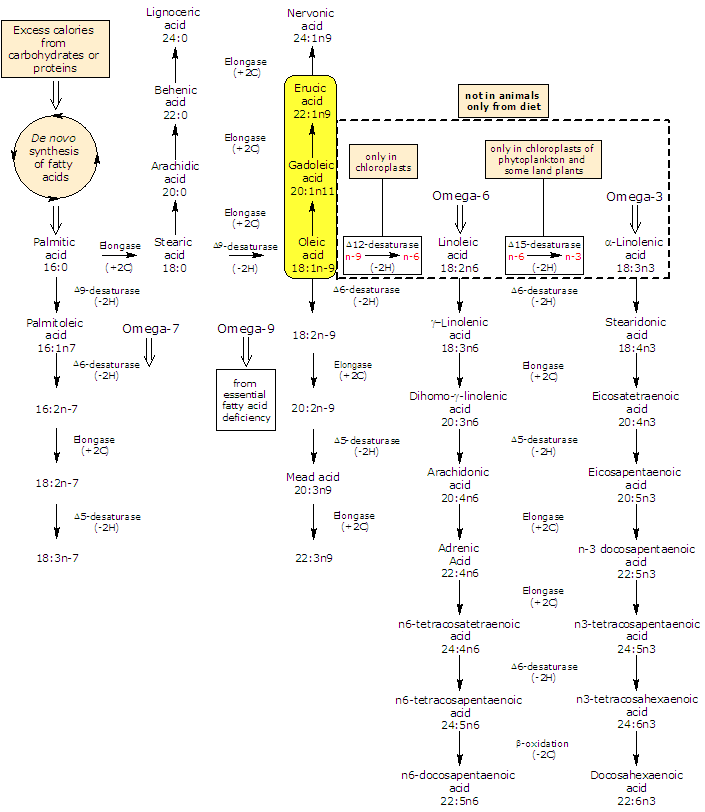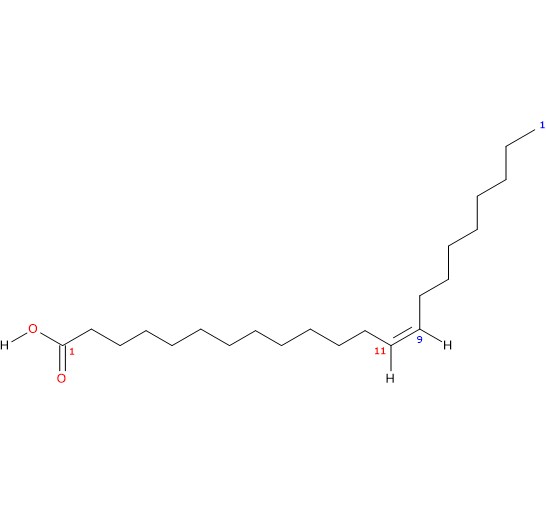Erucic acid (22 carbon atoms), from Latin word eruca, meaning arucola or garden rocket (Eruca sativa, a flowering plant of the family of Brassicaceae, synonym Cruciferae) belongs to the group of unsaturated fatty acids (one cis (Z) double bond, from the methyl end is in omega-9 (ω-9) or n-9, so in shorthand is named 22:1n-9), and is a member of the sub-group called very long chain fatty acids (VLCFA), from 20 carbon atoms onwards.
It is an elongation product of oleic acid and in animals, dietary one can be retroconverted to oleic acid.

PROPERTIES
Molecular weight: 338.56768 g/mol
Molecular formula: C22H42O2
IUPAC name: (Z)-docos-13-enoic acid
CAS registry number: 112-86-7
PubChem: 5281116

In purified form it is a white waxy solid insoluble in water, with melting point at 33.8 °C (92.84 °F; 306.95 K) and boiling point at 381.5 °C (718.7 °F; 654.65 K) at 760 mm Hg.
OTHER NAMES
cis-13-docosenoic acid
13-cis-docosenoic acid
cis-eruic acid
Z-13-docosenoic acid
13-docosenoic acid, (Z)-
(Z)-docos-13-enoic acid
delta13-cis-docosenoic acid
delta13:14-docosenoic acid
13-docosenoic acid, (13Z)-
22:1n-9
Food sources of erucic acid
Erucic acid occurs as glycerol ester particularly in the seed fats of several Brassicaceae like rapeseed (Brassica napus), mustard (Brassica junca and Brassica nigra), up 40 to 50 percent of the corresponding seed oils (e.g. rapeseed oil), and wallflower, kale, Brussels sprout and broccoli, other members of Brassicaceae.
Toxicity in humans
Because of studies on male adult rats have shown that erucic acid promotes myocardial lesions (fatty infiltration, that is, accumulation and retention of fat in cardiac tissues) Food and Drug Administration, in United States, and European commission have precautionary established that the level of the acid in edible oils must not exceed respectively 2 and 5 percent ; for this reason, it has been bred out of rapeseeds used for oil production (canola oil).
Erucic acid is the second most important component of Lorenzo’oil after oleic acid.
References
- Akoh C.C. and Min D.B. “Food lipids: chemistry, nutrition, and biotechnology” 3th ed. 2008
- Chow Ching K. “Fatty acids in foods and their health implication” 3th ed. 2008